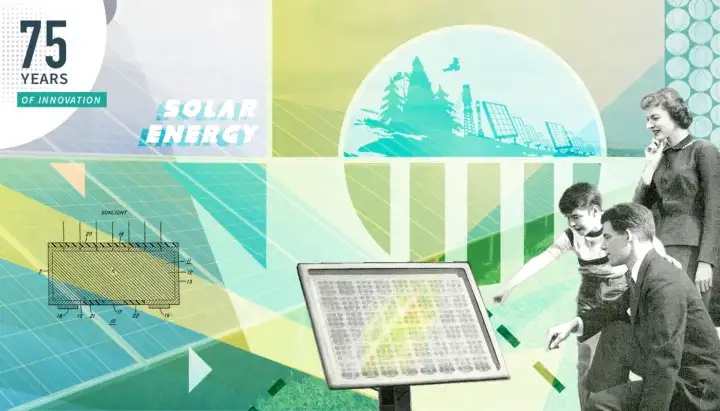The first World Symposium on Applied Solar Energy that resulted in the world’s first commercially viable amorphous solar silicon cell and several solar energy-related patents
The 75 Years of Innovation series highlights the groundbreaking innovations spanning from SRI’s founding in 1946 to today. Each week, SRI will release an innovation, leading up to its 75th anniversary in November 2021.

Making Energy While the Sun Shines
“The significance of these meetings will probably be felt as an upsurge of activity and research follows the discussion and evaluations that took place” — Guy Benveniste and Merritt Kastens of SRI International writing for Science Magazine in 1956 on the first World Symposium on Applied Solar Energy
That bright yellow ball in the sky, otherwise known as the Sun, is the essence of all life on the planet. Without its light energy, plants would not grow, lambs would not frolic on the meadow, and we would not be here to write this. The Sun is so important in human history that we have even created gods in its name, worshipping the sun’s great energetic force.
So, it is no surprise that humans want to harness this energy…
In 1955, SRI co-hosted the first World Symposium on Applied Solar Energy. Over 29,000 people attended the event to hear 500 scientists and engineers talk about the future of solar power.
This symposium turned out to be a catalyst for new ways to capture energy from renewable sources. The event resulted in a dozen patents by SRI International, generating a portfolio of technologies that make use of solar energy.
This is how SRI captured sunlight
Several inventions were born at the World Symposium on Applied Solar Energy, one being the amorphous solar silicon cell. The patent was filed in 1976 out of RCA’s David Sarnoff Research Center (now part of SRI), and would kick-start the commercial solar energy industry. The patent (Carlson U.S. Pat. №4,064,521, Dec. 20, 1977) presented a “glow discharge amorphous silicon” used to generate a Schottky barrier (a potential energy barrier for electrons formed at a semiconductor junction) along with P-I-N junction devices.
Amorphous silicon, having low structural homogeneity, has a high absorption capacity and some key commercial advantages:
- Uses less silicon: Amorphous cells use less silicon than their crystalline counterparts; substrates can be made out of cheaper materials (e.g., glass)
- Flexible and lightweight: This feature allows for wider applications
Plasma-enhanced chemical vapor deposition, a technique developed in the 1960s at Dundee University in the UK, laid the groundwork to establish the first amorphous silicon solar cells by Carlson and Wronski at RCA Laboratories. The amorphous silicon solar cell is based on a P-I-N junction. The P and N layers are doped (with atoms such as halogens, e.g., chlorine) and kept ultra-thin. The I layer is where energy is absorbed and passed to the charge carriers, i.e., the electrons and holes. Its unique selling point is that it provides a thin-film approach to the technology as an alternative to ‘wafer crystalline silicon’. These first cells had an efficiency of 2% but in the same year, the team was able to increase efficiency to 5+%.
As work continued, it was noted that the photovoltaic cells were hampered by what is known as the Staebler-Wronski Effect. This resulted in the degradation of the cell output on increased exposure to the sun. In 1977, a paper by Staebler and C. R. Wronski (of RCA Laboratories) described a method of reversing this effect by annealing the cells at 150 oC.
Since then, further refinements such as adding hydrogen to silane during decomposition, have increased efficiency. Over the preceding years, the amorphous silicon cell improved efficiency which opened it up to further applications.
Shedding light on energy: Where SRI fits in the history of solar energy
Back in the 80s, students had solar in their hands: the solar-powered calculator. It was state-of-the-art and was powered by amorphous silicon. For some time after the RCA improvements of amorphous silicon solar cells, the applications remained niche. However, as time went on, the applications of the technology increased to more general use cases for electricity generation and consumption. This included building-integrated photovoltaics which we are all familiar with today, e.g., solar panels.
The World Symposium on Applied Solar Energy back in 1955 gave rise to many patents that have enhanced the world of solar energy. Almost 70 years later, solar energy and other renewables have become not only vital but planet-saving technology. As climate change heightens, we must change the way we produce and consume energy. By harnessing solar power we can help reduce the need for non-renewable energy forms.
SRI continues to take this important work forward. Our contributions include developing a licensable process for manufacturing solar-grade silicon, a novel application of graphene for photovoltaic cells, and the development of thin-film solar cells.
Resources
World Symposium on Applied Solar Energy, Science 11 May 1956: Vol. 123, Issue 3202, pp. 826–831: DOI: 10.1126/science.123.3202.826
D.E. Carlson: U.S. Patent №4,064,521 (1977)
D. E. Carlson, The Status of Amorphous Silicon Solar Cells, Book Chapter published 1981 in Photovoltaic Solar Energy Conference on pages 294 to 301:
https://doi.org/10.1007/978-94-009-8423-3_42
Patent Application, Article and device having an amorphous silicon containing a halogen and method of fabrication, 1976: https://patents.justia.com/patent/4196438
D. L. Staebler and C. R. Wronski, Reversible conductivity changes in discharge‐produced amorphous Si, Applied Physics Letters 31:4, 292–294: https://aip.scitation.org/doi/10.1063/1.89674
Carlson, D.E., Wronski, C.R. Solar cells using discharge-produced amorphous silicon. JEM 6, 95–106 (1977). https://doi.org/10.1007/BF02660377
Carlson, D.E., Recent developments in amorphous silicon solar cells, Solar Energy Materials, 1980: https://doi.org/10.1016/0165-1633(80)90002-7


